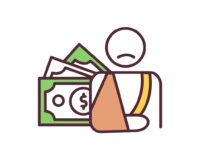It is always advisable to have reserve or emergency money to guard against financial crisis. Those who are fortunate enough to have reserve money set aside usually keep it in a savings account or money market. The idea is to keep the money in an easily accessible account and to limit any fluctuation in value. In other words, it is not a good idea to have risk in an account that you may need to draw money out of for an emergency.
Money markets and savings accounts keep money liquid and safe from fluctuation but they do not provide much of a return either. The average savings account yields less than half a percent of interest per year. The cost of sacrificed return can add up over time. For example, consider a 54 year old that keeps 50,000 in a savings account of some type of money market for 10 years. Assuming they are getting a .25% return at the end of 10 years they will have $51,264.00 in their account. The money certainly was accessible the entire time but the client only made $1,264.00 over the 10 year period.
As an alternative, a return of premium fixed indexed annuity with an income rider could be considered. The plan has 100% return of premium at any time. This provides quick (3 day turnaround) access to the initial investment at any time without any risk. If $50,000 is put into the account, it can always be surrendered for a minimum of $50,000. Accounts of this type will gain anywhere from 0% to 5% interest a year for an average of 2.5% to 3% which can offer greater growth potential than a savings account or money market.
The bigger benefit is the account will also grow as a guaranteed income stream over time. One of the more competitive companies currently offers a guaranteed growth of 10% simple interest per year. If the same 54 year old put $50,000 into this account and did not ever need to access it, they would have a benefit base of $100,000 that they could draw 5.4% out of per year guaranteed. This would generate $540 a month on a guaranteed basis for life. They would not be forced to use this option but could do so if the need for extra income arose in the future.
Many return of premium annuities also offer a death benefit option with the account. If the account holder was to pass away at any time during the 10 year period, the account would pay out the income rider value as a death benefit. To stay with our example, if the 54 year old died in year 6, the account would pay out $80,000 as a death benefit to the current beneficiary.
A return of premium annuity offers a number of advantages over the traditional safe money strategies. The account holder can still maintain liquidity while having the additional earning potential and the ability to use the money for income purposes down the road.








Recent Comments